
Syllabus CIT-100: Computer Fundamentals and Applications
Course Syllabus: Fall 2017 | Instructor: Eric Darsow
Community College of Allegheny County
Jump to a section
motorcycleIntroductory Activity
check_boxOverall Learning Objectives
buildStandard Course Info
buildPublished Learning Outcomes
buildCourse Philosophy
buildClass Norms
buildHomework
buildLate work
buildMissing Class - Come to class!
buildLearning Habits
buildAssessment
buildCheckpoints - NOT tests
buildGrading system
buildTechnical learning tips
buildDifferently Abled Students
buildPregancy
buildReligious Observance
buildChosen Names
motorcycle
Introductory Activity: Computer Networks-Kinda like magic, eh?
Exercise type: Exploration and system diagramming
The Internet is in our hands and hears. Soon to be over our eyes. It's in our cars and thermostats. Almost all tasks that we do for organizations are either completed entirely using a computer or recorded in a computer database somehow.
What computer components make these interactions possible? What are they called?
- Find your assigned class partner. Introduce yourselves. Discuss why you're in CIT 100. What is your work experience with computers? What's your favorite thing to do on computers?
- Read the introduction to the Wikipedia article on Computer Networks
 and browse the sections. Both of you try to answer the basic question: "What is a computer network?" to the other person. Re-read until you have a basic answer".
and browse the sections. Both of you try to answer the basic question: "What is a computer network?" to the other person. Re-read until you have a basic answer". - Devise a plan with the following goal: We want Partner A to do something on his/her/their mobile computer (or another desktop) that can be immediately seen on Partner B's desktop computer. We also want to do this in reverse (Partner B does something on a remote device and it shows up on Partner A's computer) Some ideas:
- Partner A finds an interesting news article and uses that website to send a link to Partner B's email account.
- Partner A connects to Partner B through a real-time text exchange (chat) utility. Discuss something that's interesting to both of you.
- Play a game with one another using your preferred gaming website such that actions of Partner A in the game show up on Partner B's game screen.
- Document the magic with a photograph of some kind, if possible. We want to document both computers interacting with one another
- What pathways did the requests and replies take to make each of these interactions possible? Create a paper version of the flow of information from One Partner's device through some network of computers, and eventually to the other Partner's computer.
- Discuss your flow charts with the class and teacher, and make changes as needed.
- Create a digital version of this flow chart in a flow-charting program, such as draw.io (best used with a Google account login).
- Export your flow-chart diagram from your flow charting program and save it on your desktop's hard drive as an image file with a descriptive file name (no spaces or strange characters)
- Upload any artifacts you have to our Google Drive artifact document. Find your individual page and format it such that it is easy to read and pleasing to the eye.
Overall Course Learning Objectives
At the end of the course, students will be able to
| check_box | Think and design like designers of computer systems think and design: in terms of components and how they work with other components to get something useful done for the user (i.e. load a website) |
|---|---|
| check_box | Create structured documents to present useful data (information) electronically and in print to other humans |
| check_box | Comfortably oragnize, manipulate, and share data using a spreadsheet! We shall not fear spreadsheets! |
| check_box | Navigate computer operating systems, specifically its file system, to run application software |
| check_box | Become best friends with the most comprehensive and up-to-date source of sources on the internet: Wikipedia |
Course Info
| Category | Content |
|---|---|
| Registration Classification |
Number and Title: CIT 100 - Computer Fundamentals and Applications |
| Catalog Description |
This is a general computer literacy course. Students learn computer fundamentals (hardware, software and using a Microsoft Windows operating system), essential applications (word processing, spreadsheets, database and presentation software), working online (networks, using the Internet and email) and the impact of computing and the Internet on society. Students develop skills with common applications to use a computer as a tool, make informed decisions concerning computer generated information and obtain basic information systems concepts and terminology. |
| Prerequisites | None! |
| Sections |
Section NC35 (Day): CCAC North
Section WH71 (Evening): CCAC West Hills |
| Instructor Information |
Eric Darsow |
| Course Materials |
Technologyrediscovery.net is your home for this course. We will most likely not use a BlackBoard course site since the system is a pain to use for getting basic information easily and quickly (and it's closed source software). We'll prioritize resources that are available for no charge on via the internet, all of which will be linked via our session pages linked on the course schedule. No need to buy the assigned text associated with this course since it's not very useful for most students. If there is important content from the text, your instructor will post a reference to it or summarize it within our course documents. |
| Required Materials |
Please have access to a computer running an operating system and these basic office productivity application types:
Since many workplaces require staff to use computers running the Microsoft Windows operating system and Microsoft Windows office productivity suite, it may be helpful for you to have a computer of your own running the Microsoft Corporation's software on which to practice and prepare assignments for this course. This is closed-source software, is very expensive for non-students, and you will not be required to use this software. As a student at CCAC, the Microsoft Corporation will grant you a student-use license for the Office 360 suite. Information on installing this software using the Microsoft software control system called Imagine is available on the CCAC Technology Services website. NOTE that as soon as your student status at CCAC ends, the Microsoft Corporation will revoke your Office 360 license and the software you had installed on your computer will no longer perform any essential functions and any information you may have stored in their OneDrive cloud system will become inaccessible. At this time, you will be required to pay for a recurring non-student license that costs $100 per year until the day year you die. If you would like to use free and open source technology to learn computer fundamentals, you can download and install a fully featured office suite called Libre Office which costs zero dollars and the license will never expire or convert into a paid license. Libre office is available for free download onto Linux, Windows, and OSX systems and the suite contains tools that mirror all of the MS Office functions required for this course. |
Learning Outcomes
The following content is extracted directly from the CCAC master course syllabus for CIT 100:
The learning outcomes are consistent with the requirements of IC3, an industry-recognized certification program that covers a broad range of computing knowledge and skills to prove competency in essential computer areas. The Internet and Computing Core Certification (IC is a global, validated, standards-based training and certification program for basic computer and Internet knowledge and skills. Upon successful completion of the course, the student will:
- Computer Hardware:
- Identify different types of computers, how computers work (process information) and how individual computers fit into larger systems.
- Identify the function of computer hardware components and common problems associated with individual components.
- Identify issues relating to computer performance and how it is affected by different components of the computer.
- Identify the factors that go into a decision on how to purchase a computer or select a computer for work, school or home.
- Computer Software
- Identify how software works and how software and hardware work together to perform computing tasks.
- Identify different types of software, the tasks for which each type of software is most suited and the popular programs in each software category.
Course Philosophy
As a 100-level introductory course, this class is structured to provide students with exposure to a variety of core concepts relating to computer technology today. The fun part about this process emerges from the clever and intriguing nature of how computers actually work as systems to accomplish very complicated tasks--both computationally (crunching numbers) and coordinationally (connecting computers through the internet).
As an overview course, we will not dive into any one topic, nor will students be expected to memorize and repeat back facts or ideas related to individual subject areas. Rather, we'll work to understand the interaction between parts and find elements of the systems that are of interest to each of us and explore those through mini projects.
Attention will be directed at so-called office productivity applications such as word processors, spreadsheets, databases, and presentation tools. To develop a strong foundation for learning about these essential software packages, we'll learn about operating systems and how they function as a platform on which the software we all know and love rest.
Course Norms
We can consider our class like a mini-community of folks who are working on a project together, in this case, we're learning about computer fundamentals. I've done some thinking about how we can work together and stay happy while doing so, and propose the following group norms which hopefully can become shared values by class members. To avoid blobs of text, I've made little cards describing the norms so we can discuss them in class.
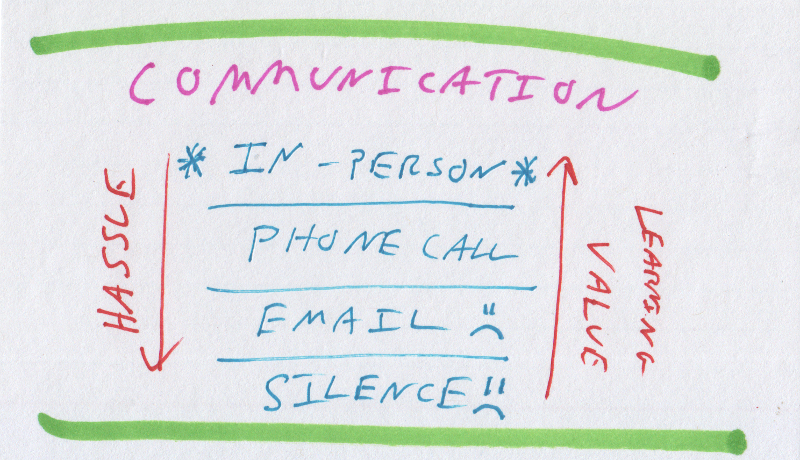
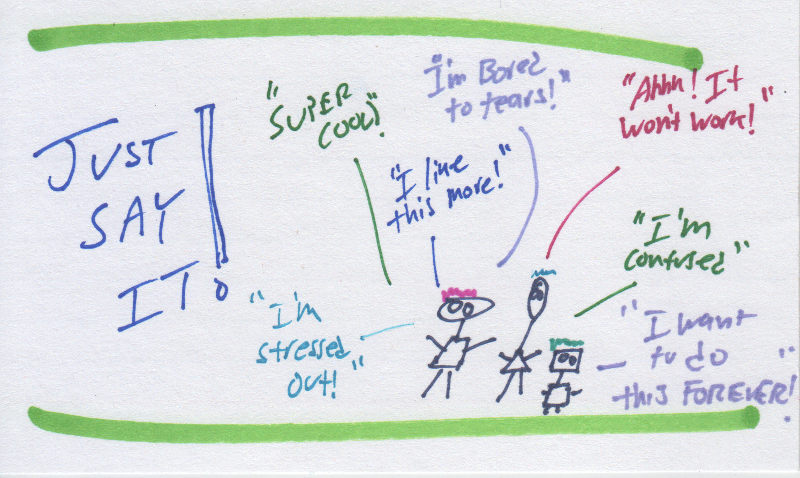
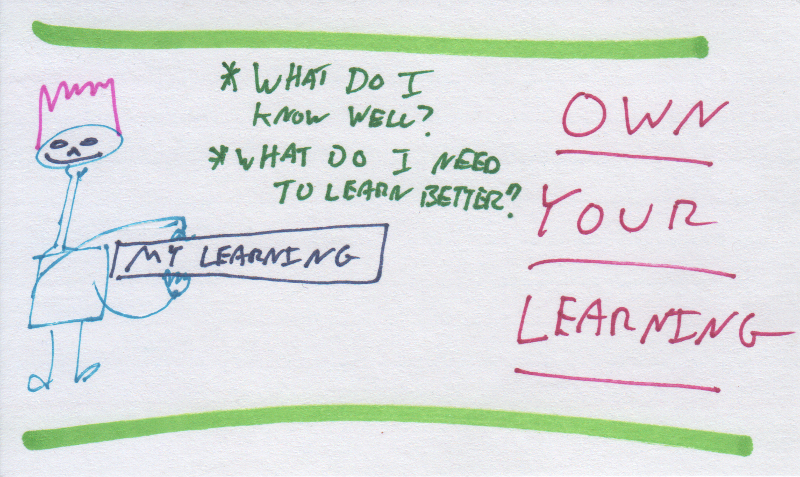
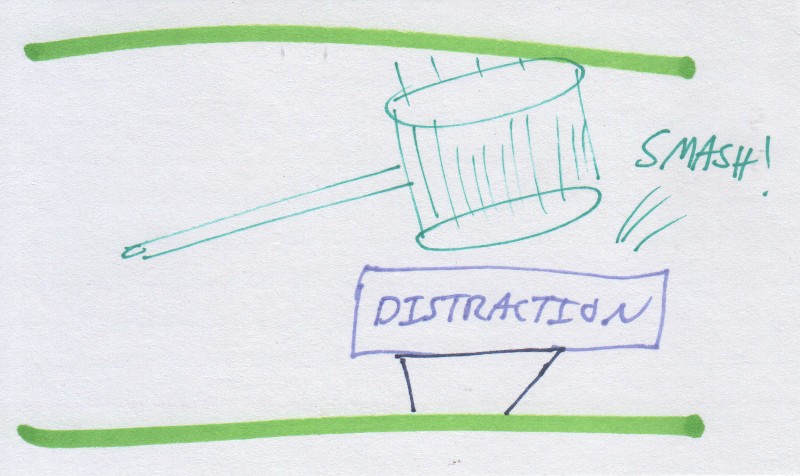
Practice / "Homework" structure
As an introductory and overview course, our most important time together will be during class sessions. (If we can't make some solid learning happen with the three or four hours per week we spend with each other, then we're not doing very well!) Given this, most lessons will not require work outside of class. You are, however, encouraged to apply this learning to interesting projects or ideas you have going on in the rest of your life and bring those ideas in to share with the class.
"Late work"
The order in which we learn stuff certainly matters a lot, but exactly when a particular chunk of learning happens doesn’t impact the quality of that learning. With this principle in mind, I accept all assigned work up until the day before CCAC’s college-wide grade submission deadlines (for mid-term and final).
Keeping pace with the class, however, is likely to be very important to your learning process. For example, what we learn in chunk 4 is an extension of what we we’ll study in chunk 3. If you have put off doing out-of-class practice, you won’t be comfortable with chunk 3 stuff and you’ll likely be confused by the new content, and this is do doubt frustrating for everybody involved. So do yourself a favor, and, when possible, schedule out regular time to practice our class skills and work through exercises.
Missing class sessions
Come to class! We want you to be part of the group! I’m here to help you learn stuff, so communicating with me about your class attendance is important so I can help keep you on track with the course.
If you miss class, please find some time in your life to work through whatever exercises have been posted for the day you were absent. Make note on what you would like more support to learn. Then come to office hours (posted on our course website) and ask questions or work through stuff that you couldn’t figure out.
If you miss class and I don’t hear from you, I’ll likely drop you an email and check in to see how you’re doing. If you’ve missed 2 class sessions and I haven’t heard from you via email or phone, I’ll probably call you to check in, so best to save my contact numbers in your phone.
Core Habits for Meaningful Learning:
- Deliberately practice developing your skills independently and/or in groups – outside of class – a few times a week. Practice distraction free: silence phones, use music sparingly, and work somewhere you can focus.
- Think of computer tools as instruments that can create their version of “music.” Treat them as such and learn your instrument’s ins and outs. Learn how it works on the inside as much as you can—even if it doesn’t seem immediately relevant. It will pay off big time in the future when you have to get it to do new things.
- Monitor for yourself what you don’t yet understand or can’t yet do and systematically exert effort to understand that stuff or do those things.
- Tinker with your tools, and break stuff (code, applications, operating systems, networks) and figure out how to fix it. This is the advantage to learning computers—breaking them doesn’t cost anything like it does in, say, woodworking, where messing up means wasting wood.
- Honor important waypoints in your learning process. (“When it really counts, make it happen.”) by being fully prepared for checkpoints and work sharing events presentations, etc.
- Make explicit note of any learning aids you use (“cite your sources”) during any work you do in this course. Include links to code you heavily reference and make happy note of major breakthroughs you made on your own.
Assessment of Learning Progress
High-stakes tests, exams, quizzes that make and break grades have generally given the notion of assessment in education a bad flavor in many folks' mouths. We shall, in this course, attempt to take back assessment as a useful tool for figuring out what we know, and what we have yet to learn, and aligning the course to make that happen. Here are some cards describing some assessment mechanisms we'll use in this course:
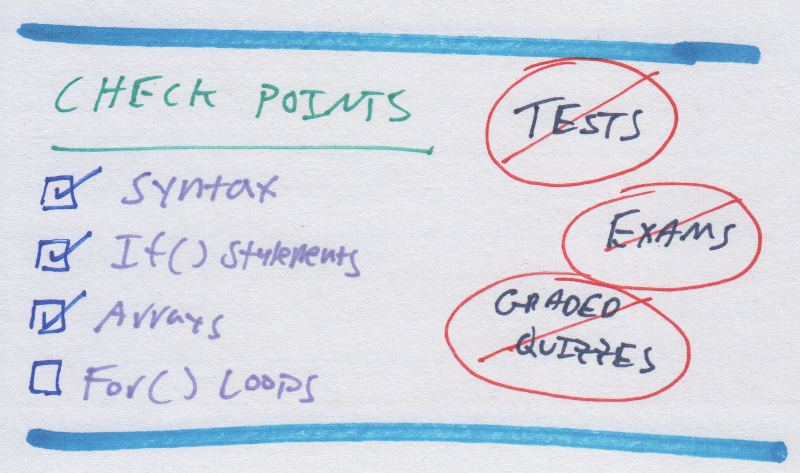
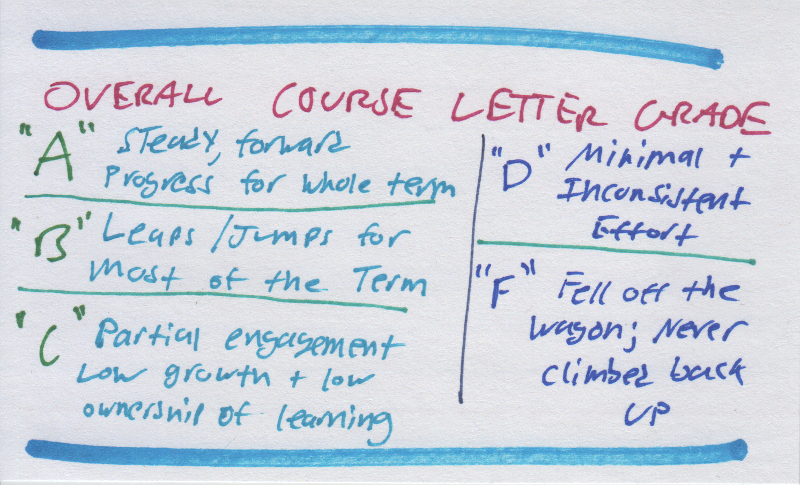
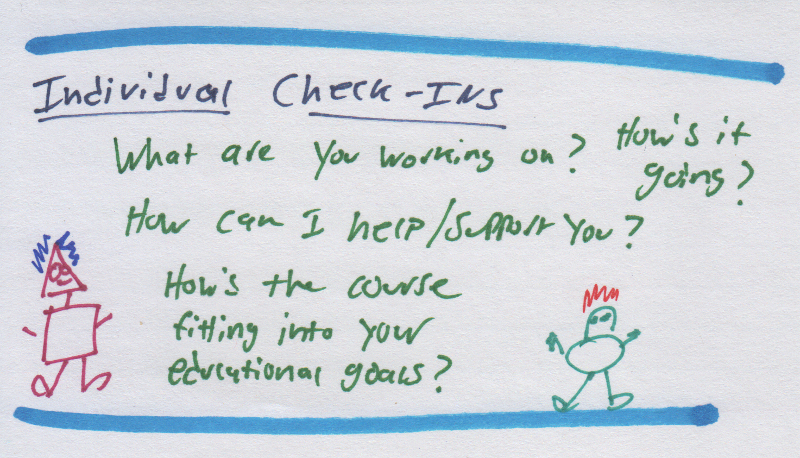
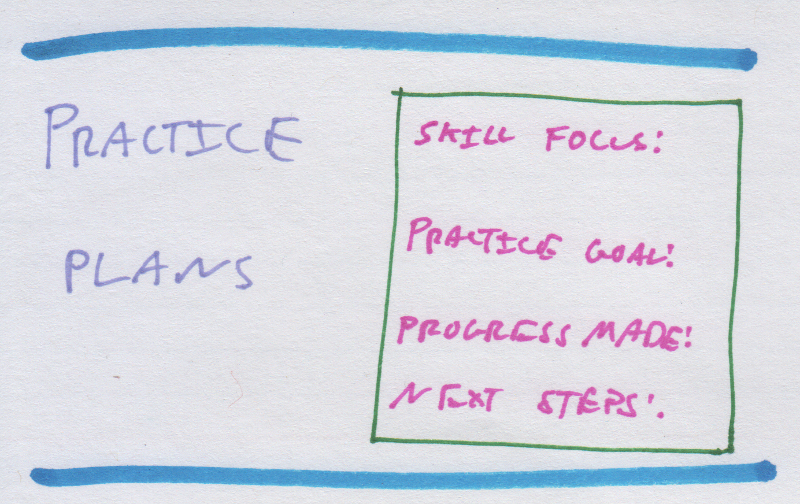


Checkpoints (not tests!):
This course will not involve tests that are high pressure, completed entirely independently, and heavily weighted. Rather, the course is designed to encourage and support regular practice which leads to incremental learning. Many courses that heavily weight tests end up encouraging students to cram in content learning directly before each major exam, and this often detracts from the regular practice that is likely much more important to becoming a proficient computer user.
In this spirit, we will have a few checkpoint tasks that are completed during class and involve completing a mini programming project that you have not previously seen. The goal of the checkpoints is to practice your evolving skills and to communicate with me about your learning progress so I can support you as much as possible in meeting your educational goals. They should be prepared for using the preparation guides on the course website, but they are not designed to be stressful or “make or break” in quality. They are literally a checking in about your progress through learning Java. Nothing more, nothing less.
The mini-project for the checkpoints should take approximately 2 hours to complete (the entire class session) and will demand that you apply all of the core concepts learned in the course up to that checkpoint time. (Languages are by definition cumulative, so what we learn during the second class period, for example, will be required for all future classes and checkpoints).
During the checkpoint, you will be encouraged to use any and all programming resources that you find helpful, including the Java API documentation and community forums like StackExchange. Of course, your use of these resources must be cited appropriately in your code—through comments—just as you should always do, forever and ever, throughout your programming journey.
I will be around to provide guidance during the checkpoints, but will be mindful of creating an experience that checks your learning so far, not mine. So I may not answer questions with the same degree of explanation as I might during a normal class session.
You will receive written or verbal feedback on your checkpoint program within a week of its completion.
Course Letter Grades
Core assessment principle: The most important outcomes of the course is the degree to which students are comfortable implementing their new skills and knowledge in “real world” situations (i.e. to solve meaningful problems)
This course aligns with CCAC’s college-wide grading policies which require teachers to issue each student a cumulative course grade of A,B,C,D or F. Both the student and faculty handbooks associate each letter grade with the following performance-related words:
- A – Superior (4)
- B – Above Average (3)
- C – Average (2)
- D – Below Average (1)
- F – Failure (0)
The letter grade you earn in this course is translated, by a computer, into a grade point value (the number in parenthesis) which is awarded to students on the standardized 4.0 scale and used to determine each student’s cumulative grade point average (GPA) across all courses “taken.”
These grading guidelines are somewhat mysterious, however, because a “C” as an average grade in a course would mean that about half the students would be given a “D” or “F” and this not something we want because it’s discouraging to students and not an accurate picture of student learning.
Thankfully, the college does not require that each course’s overall student grade set actually averages to a “C”. (This process is known as “curving” or “grading on a curve” and is only implemented with mathematical precision in very competitive and extremely selective academic institutions. ) This course does not, therefore, adjust any individual student grades based the grades of other students. (Everybody could earn an A!)
Further, to allow for variation across disciplines and teacher approaches, the method for final grade determination is not specified in college policies and is delegated to individual teachers to design. This course will implement the following process for determining final student grades:
1. I will hold a grade conversation with each student three times throughout the term: at each of the two checkpoints and at the end of the term. We’ll discuss your involvement with each Core Habit for the course. I’ll suggest where I think you are “sitting” in terms of a letter grade and you can add more information or suggest changes to this determination. We’ll come to a consensus and I’ll record the outcome of that conversation in my trusty blue teacher grade book.
2. When grades are due, I’ll open the blue teacher grade book, work down the roster student by student, and look for an obvious pattern or trajectory in the outcome of the three grade conversations. Students generally fall into one of these three patterns, and final grades are determined with these principles.
Suggestions for successful technical learning
We are working to learn how to use a computers—really fancy adding machines—to help us do stuff that’s useful like organize, store, and present data. Since computers are very complicated, successful learning should adapt to this environment. The following principles can be thought of as suggestions for building your computer knowledge and are based on my experience learning many new technical topics from scratch over the past few years:
- Find a book, tutorial set, or other learning resource that applies to the topic you’re studying and devour it all. Avoid skipping around and switching resources once you have found one that works with your learning style. This will help maintain a steady learning path and increase the quality of your knowledge.
- Locate the technical documentation for any tools you are using and study it carefully. These materials are usually written and published by the creators of the tools themselves. Become intimately familiar with the way the documentation is structured so you can find the information you need quickly when the moment arises.
- Expect your learning to spiral upward as you learn more and more about the important topics that are connected to your study. Since topics are often interrelated and complex, expect that you’ll need to be exposed to the same topic or idea a few times before it soaks in.
- Find a mentor or friend whose a little more proficient in the system than you are—as him/her/them questions often. Soak up what they know whenever possible. Work together when possible.
- Challenge yourself by not asking for help the moment you get stuck—tinker a bit. Experiment with a solution and see if it works. Working through confusion is an incredibly meaningful step in technical learning, since once you’re doing paid work, you’re expected to know how to solve problems.
Accommodations for Individuals with Disabilities:
The college recognizes its responsibility to provide academic and nonacademic services and programs equally to individuals with and without disabilities. To this end, the college provides reasonable accommodations for qualified students and employees with documented disabilities consistent with the requirements of the Americans with Disabilities Act, sections 503 and 504 of the Rehabilitation Act and other federal, state and local laws and regulations. The college maintains an Office of Supportive Services at each campus location to receive, review and evaluate requests from students who require an accommodation with respect to their educational program. Students’ requesting reasonable accommodations due to a documented disability must first register with their campus’ Supportive Services Office and obtain an official letter identifying approved accommodations to be distributed to their faculty members.
Attendance Procedure for Pregnancy and Pregnancy Related Conditions:
In accordance with Title IX of the Education Amendments of 1972, absences due to pregnancy or related conditions, including recovery from childbirth, shall be excused for as long as the absences are determined to be medically necessary. Students will be provided with the opportunity to make up any work missed as a result of such absences, if possible. For more information or requests for accommodations, students should inform their instructor(s) and/or contact the Civil Rights Compliance Officer/Title IX Coordinator, Sumana Misra-Zets, at 412.237.4535 or smisra@ccac.edu.
Attendance Procedure for Religious Observance
The college will make reasonable efforts to accommodate students who must be absent from classes or miss scheduled exams in order to observe a religious holiday or participate in some other form of religious observance. Students shall be provided, whenever possible, reasonable opportunity to make up academic assignments missed due to such absences, unless doing so would create or impose an undue burden on other students or the College. It shall be the students’ responsibility to provide written notice via the Request for Accommodation for Religious Observances Form (accessible at https://www.ccac.edu/nondiscrimination/) to every instructor for each course in which an accommodation is being requested. For more information contact the Civil Rights Compliance Officer/Title IX Coordinator, Sumana Misra-Zets, at 412.237.4535 or smisra@ccac.edu.
Chosen First Name Procedure for Students
Many individuals use names other than their legal first name to identify themselves for a variety of personal and/or cultural reasons. The college seeks to provide an inclusive and non-discriminatory environment by making it possible for students to use a chosen first name on college records when a legal name is not required. Chosen first names may not be applicable in certain programs due to the requirements of accreditation organizations and clinical sites. For more information, please see the Student Handbook